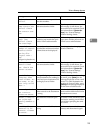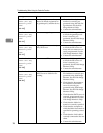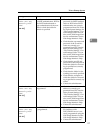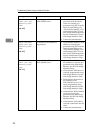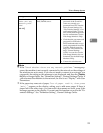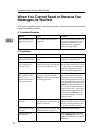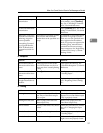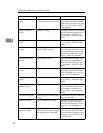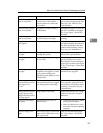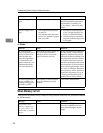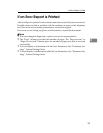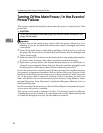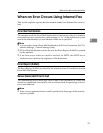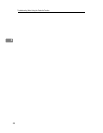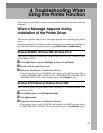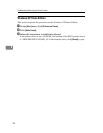
When You Cannot Send or Receive Fax Messages as Wanted
33
3
Printed images contain
blots or are patchy.
Check the machine is set on a hor-
izontal surface. The machine
must be placed on a stable and
level surface.
Check the environment of loca-
tion to select an appropriate loca-
tion. See p.119 “Where to Put
Your Machine”.
Printed images contain
blots or are patchy.
The paper is creased, curled, or
has blemishes.
Straighten the paper if curled. Re-
place it if wrinkled or damaged.
See “Copy Paper”, About This
Machine.
Printed images contain
blots or are patchy.
The paper is too thick, curled, or
the print density is too high.
Lower the envelope lever for
printing.
Image blurs or double
lines appear.
The printheads are misaligned. Adjust the head positions. If they
are still misaligned, print the noz-
zle check test pattern, and then
perform head cleaning, if neces-
sary. See p.94 “Maintenance”.
The image is too dark or
too light.
The expiration date of the print
cartridge has passed.
Open the print cartridge and use
it before the expiration date.
The image is too dark or
too light.
The correct paper type settings
are not made.
Check if paper loaded on the pa-
per tray, bypass tray or One-
Sheet Bypass Tray matching the
paper type set on the control pan-
el. See “Copy Paper”, About This
Machine.
The image is too dark or
too light.
Using print cartridges not recom-
mended by the supplier or refill-
ing the print cartridge may
degrade the print quality or cause
a malfunction.
Use only print cartridges recom-
mended by the supplier.
The printed text or col-
ours look different from
what appears on
screen.
The ink may be dry or the nozzles
of the printheads may be clogged,
preventing effective discharge.
If the machine has not been used
for a long time, print the nozzle
check pattern and perform head
cleaning, if necessary. See p.94
“Maintenance”.
Background of received
images appears dirty.
Images from the back of
the page appear.
Image density is too high. Adjust scan density. See “Image
Density (Contrast)”, Facsimile
Reference.
Printed or sent images
are spotty.
The exposure glass, ADF, or
ARDF is dirty.
• Clean them. See p.123 “Main-
taining Your Machine”.
• Make sure that ink or correc-
tion fluid is dry before placing
originals.
Received image is too
light.
When using rough, or processed
paper, areas of print may not be
fully reproduced.
Only use recommended paper.
See “Copy Paper”, About This
Machine.
Problem Cause Solution



